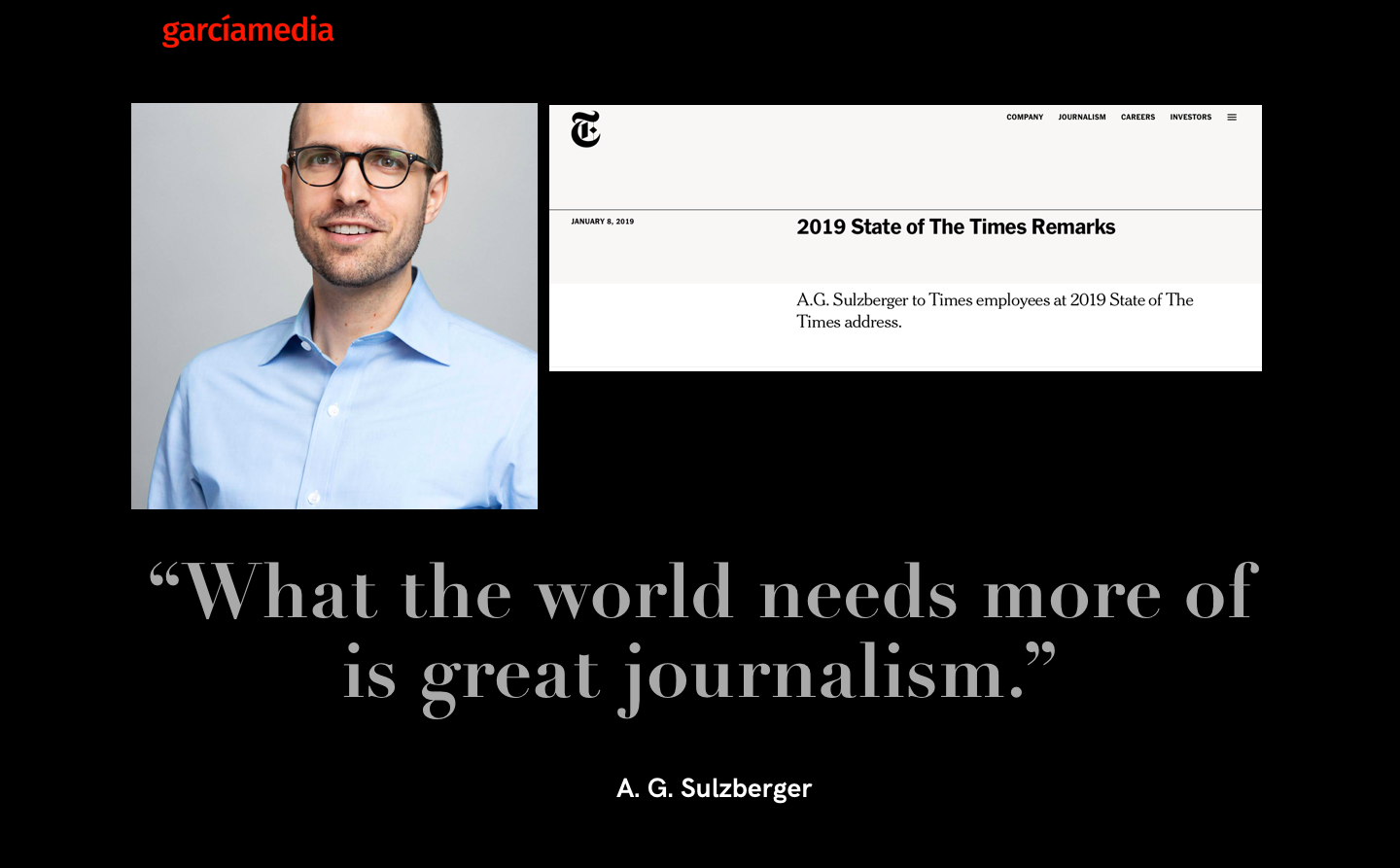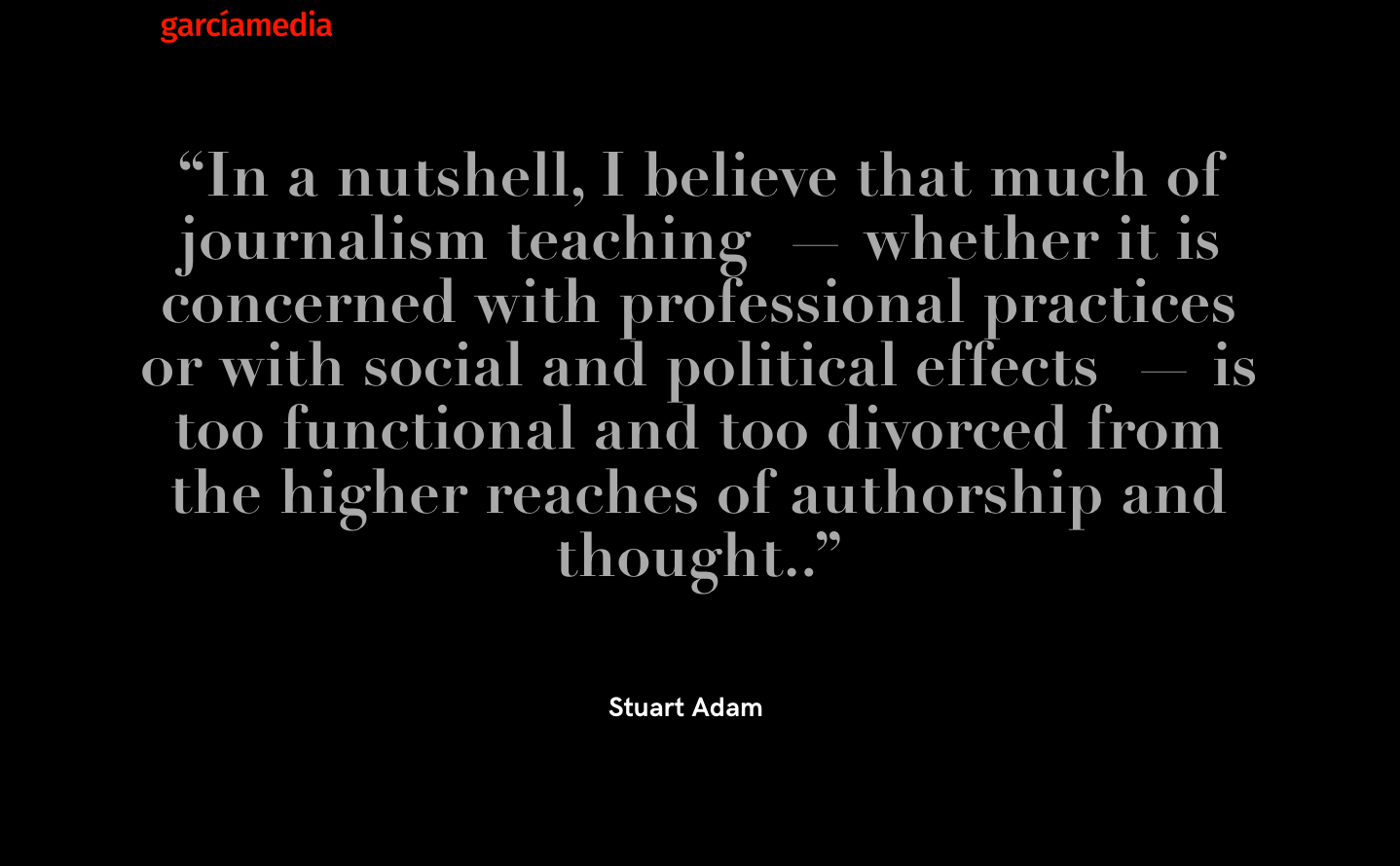A year of firsts at The New York Times

It’s that time of year when NYT publisher A. G. Sulzberger offers his “State of The Times” address, which is now uploaded online.
As readers of TheMarioBlog know, I am a big fan of The New York Times and all the Times’ team does. I especially admire the spirit of transformation that prevails, making it one of the best journalism textbooks and catalogs of visual storytelling. The Sulzberger State of the Times brilliantly summarizes why the Times is at the top of its game, citing specific examples of coverage and stories of 2018 that represent landmark moments. Perhaps the most resounding sentence in the entire piece is this:
What the world needs more of is great journalism.
Highlights:
-The Writing
The quality of our writing has long been unrivaled. We produce more words every week than Shakespeare did in his lifetime.
-Good Journalism
Many of you have heard me say that the world doesn’t need more “content.” There are enough hot takes, chat podcasts, and YouTube videos to sustain us through the apocalypse. What the world needs more of is great journalism.
And there are many ways journalism can be great. Original, on-the-ground reporting can unearth important new information. Smart, expert commentary can add nuance and understanding. Elegant, ambitious storytelling can delight and entertain.
-Not the gray old lady anymore
This was also the year we had to create a new category of journalism to live alongside old standards like beat reporting, investigative journalism, and breaking news.
We call this category “Stuff I Can’t Believe Appeared In The New York Times.” These are the stories that showed us loosening up a bit and having some fun. For example, using a pixelated squirrel to answer 104 questions about the Royal Wedding, such as: “Will any corgis be in attendance?”
Saying goodbye to a giant journalism scholar
STUART ADAM (1939-2018)

Photo courtesy www.poynter.org
Journalism scholarship lost one of its most brilliant voices with the death of Stuart Adam last December 26.
Stuart was Professor Emeritus at Carleton University, in Ottawa, at the time of his death, an institution that he had joined first as an undergraduate in the Journalism program in 1959 and where he later served as Director of the School of Journalism and Communication, Dean of Arts, and Provost of the university.
I had the honor of meeting Stuart when he came to speak at The Poynter Institute for Media Studies. At the time I was director of the Visual Journalism program there. Stuart was a teacher’s teacher. His presence at the Institute elevated all of us to think about our craft differently, more intellectually perhaps. After each of Stuart’s presentations we felt we were at a higher place, with greater admiration for journalism in all its forms.
Stuart married my dear friend Pegie Stark, a well known editorial designer , color expert and teacher, whom he met at the Institute. That’s how I had the privilege of becoming Stuart’s friend, alternating socially with Stuart and Pegie at a variety of functions, including parties at my home in Tampa. The conversation often turned to journalistic design, of course. Stuart was a visual thinker and would offer his takes on typography, color, the positioning of elements, but always as it related to the basics. “Good design exists to make the content easier to absorb,” he would remind us. I remember an occasion in which Stuart sent me a page he thought was well designed. It wasn’t the usual stunning feature page from a food or travel section. Instead, it was a page from a book he was reading. “Take a look at the way the typography was used here,” he wrote.
To Stuart, it was all about the words, and he had great respect for the typography that dressed them. And for the designers who made it happen!
That was Stuart Adam, a captivating man whose lessons and insights stayed with all who had the privilege to meet him and to learn from him.
My friend and Poynter colleague, Roy Peter Clark, who founded and directed the Writing Program at the Poynter Institute, has written a wonderfully rich tribute to his friend Stuart Adam. More than a heartfelt farewell from one friend to another, it is also an essay about good journalistic practices, and, especially, about Stuart’s deeply felt and amply shared ideas concerning journalism education and the training of journalists. I will require that my students at Columbia University read this piece the first week of the new semester, especially as it includes a rich reference list to works that all aspiring journalists should read.
As with the Sulzberger piece, here, too, we find definitions of good journalism that transcend time.
In both cases, we feel energized about and proud of our craft.
That was exactly the feeling at the end of one of Stuart Adam’s brilliant presentations. May he rest in peace.
Read the Roy Peter Clark tribute here:
Highlights:
What makes a work of journalism good?
The best way to explain Stuart’s thinking about journalism as a liberal art and as a democratic craft is to track back to its origins. He reached a moment of clarity, he said, when he accepted the task of judging in Canada a journalism competition. As often happens, the judges were presented with nominated stories from many newspapers from which they would choose the winners. But on the basis of what criteria? These turned out to be vague. Always the systematic thinker (even when learning golf), Stuart created for himself a grading rubric. It had five parts:
News Judgment: A great story should communicate something interesting and important about our world and the times we live in.
Reporting: The focus of any important work of journalism should be derived from evidence; gathered from traditional and non-traditional sources of narrative and information; and be work that is gathered and thoroughly checked.
Language: Excellence in the use of language extends from “the civic to the literary,” either by making hard facts easy reading, or by telling stories in compelling ways.
Narrative: Works of journalism could be expressed in a rich variety of ways: some traditional, using the inverted pyramid, and some experimental, such as serial narration or work that included rich visual elements.
Interpretation: It was one thing to gather and report facts. It required another level of critical thinking to analyze those facts, or to organize them in a way that makes sense to the reader. Scoops could not only come as flashes of information, but also as new enlightened ways of seeing.

TheMarioBlog post #2976